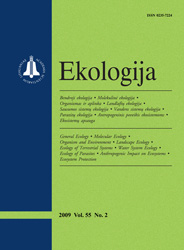 ISSN 0235-7224 ISSN 2029-0586 (online) |
2008 m. Nr. 3 Selection of micromycetes capable of developing on technical lubricants
This article briefly reviews literature data on industrially used lubricants. Their chemical composition, sources of origin, fields of application and function, as well as wastes formed after their usage and the importance for the environment are described. Various microorganisms, among numerous micromycetes capable of destroying lubricants and using them for nourishment, continuously find their way into a lubricant with dust or by other channels. In order to identify micromycetes capable of destroying technical lubricants, eight species of micromycete strains were isolated from dust accumulated in herb and spice hothouses. This was due to the fact that the accumulation of this dust is determined by the diversity and composition of the substances detected in herb waste; part of those components are constituents of lubricants. The following widely spread micromycetes were studied: Alternaria alternata, Chrysosporium merdarium, Gilmoniella humicola, Trichoderma harzianum, Fusarium proliferatum, Aspergillus niger, Aureobasidium pullulans, Geomyces pannorum as well as the following widely used components of lubricants: formaldehyde releasing triazine biocide (FRTB), overbased calcium aulphonate in mineral oil (OCSMO), oxidized wax with Ca in mineral solvent (OWNCMS), low erucic rapeseed oil (LERO), mineral oil with heavy naphthenic vacuum distillates (MOHNVD), chlorinated hydrocarbon (CHC53). It has been determined that Chrysosporium merdarium, Alternaria alternata, Fusarium proliferatum, Geomyces pannorum are the most active lubricant destructors. Paecilomyces carneus, Botrytis cinerea fungal strains occupy a particular place in lubricant destruction on the list of fungi. FRTB showed the most pronounced effect on fungal growth and development under the conditions of our experiments, while the effect of LERO was the weakest. The selected micromycetes as well as the methods of stimulation of their action and technological regulation can become a tool enabling to diminish environmental pollution with wastes of technical lubricants, thus improving the ecological conditions of the environment. Keywords: micromycetes, selection, technical lubricants, deterioration, metabolite, environment, ecological condition |
Issues:
2011 - Vol.57 No. 1, No. 2 2010 - Vol.56 No. 1-2, No. 3-4 2009 - Vol.55 No. 1, No. 2, No. 3-4 2008 - Vol.54 No. 1, No. 2, No. 3, No. 4 2007 - Vol.53 No. 1, No. 2, No. 2.priedas, No. 3, No. 4 2006 No. 1, No. 2, No. 3, No. 4 2005 No. 1, No. 2, No. 3, No. 4 2004 No. 1, No. 2, No. 3, No. 4 2003 No. 1, No. 2, No. 3, No. 4 2002 No. 1, No. 2, No. 3, No. 4 2001 No. 1, No. 2, No. 3, No. 4 |